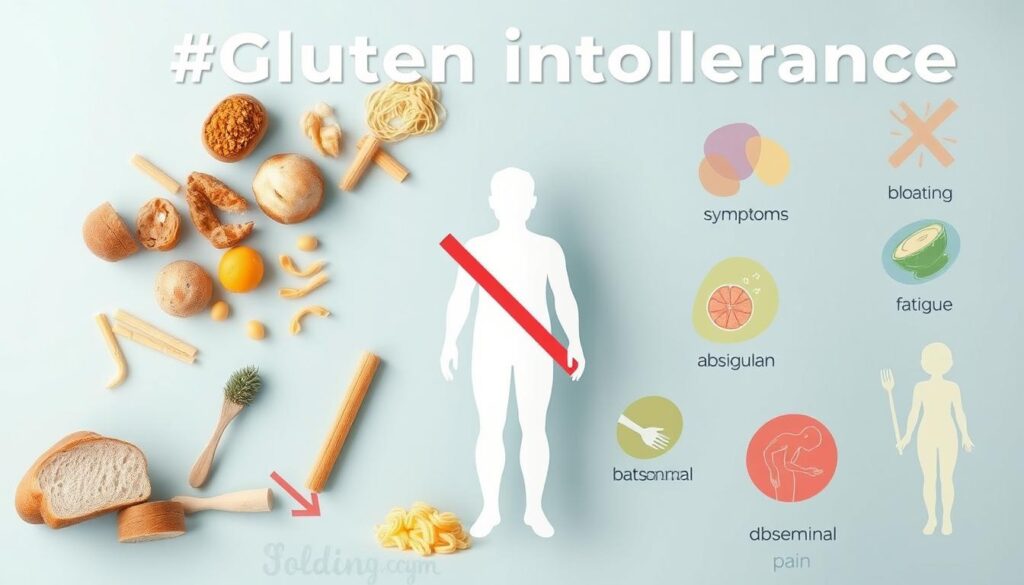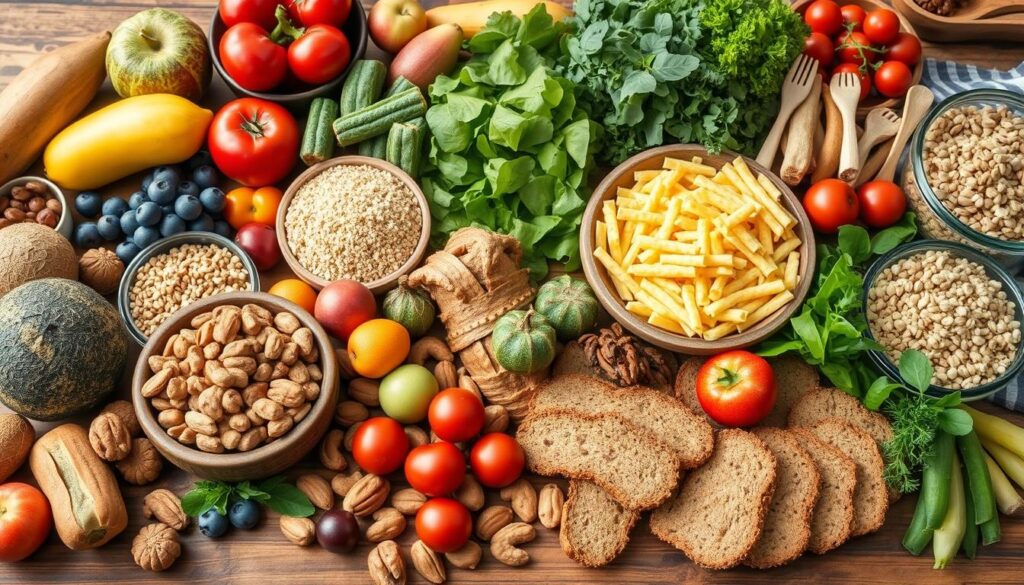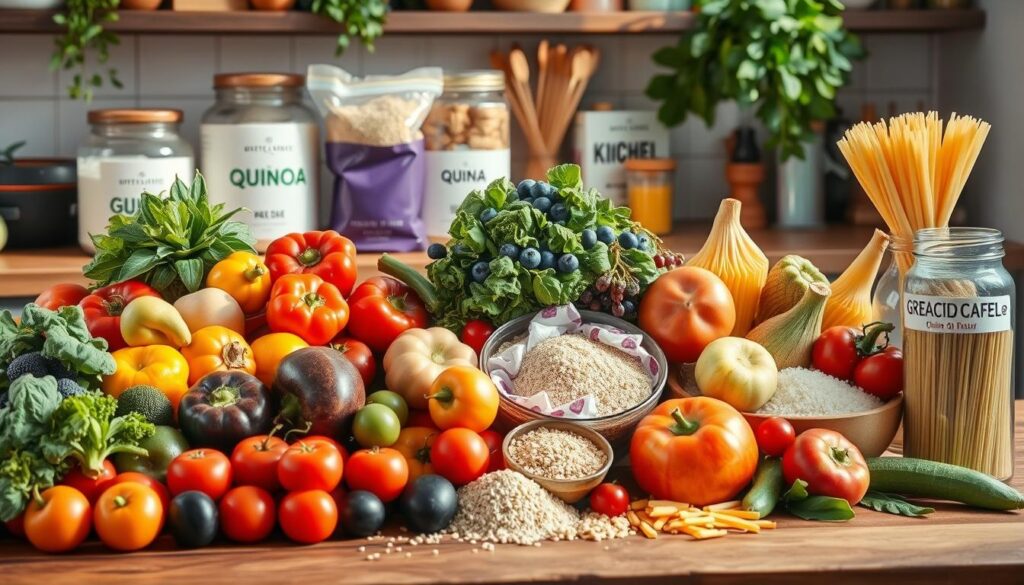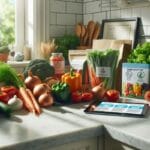Starting a gluten-free journey can feel both exciting and scary. But, with the right help, you can find your way easily. Let’s explore the world of gluten-free living together. You’ll discover its benefits and how it can help you be your best self.
Ever thought a gluten-free diet plan could improve your health? It’s not just for those with celiac disease. This guide will teach you how to make smart choices for your health.
Key Takeaways
- Understand the basics of gluten and its health effects
- Find out where gluten hides and how to avoid it
- Discover tasty, healthy alternatives to your favorite foods
- Learn to read labels and shop for gluten-free items
- Enjoy eating out without worrying about gluten
Understanding Gluten and Its Effects on Health
Dealing with dietary restrictions can be tough. But knowing about gluten and its health effects is key. Non-celiac gluten sensitivity is a growing concern. It’s when people react badly to gluten but don’t have celiac disease. Learning about gluten and its health impacts helps us make better diet choices.
What Is Gluten and Where Is It Found?
Gluten is a protein in grains like wheat, barley, and rye. It makes food elastic and holds things together. Gluten is in many foods, but also in sauces, condiments, and some meds. Knowing where gluten is helps those on a gluten-free diet plan.
Health Conditions Related to Gluten Sensitivity
- Celiac disease: An autoimmune disorder where gluten damages the small intestine.
- Non-celiac gluten sensitivity: Digestive issues, fatigue, and other symptoms from gluten, without celiac disease.
- Wheat allergy: An allergic reaction to wheat proteins, causing symptoms like hives and swelling.
Signs and Symptoms of Gluten Intolerance
Knowing the signs of gluten intolerance is important. Symptoms include bloating, pain, diarrhea, and fatigue. Headaches and skin rashes can also happen. Paying attention to how you feel after eating gluten is key.

Understanding the nuances of gluten sensitivity is key to managing our health and maintaining a balanced, nutritious diet.
Getting Started with a Gluten-free Diet Plan
Starting a gluten-free diet plan can seem tough at first. But don’t worry, we’re here to help. We’ll guide you through the first steps to make it easy and stress-free.
First, fill your pantry with gluten-free basics. You’ll need things like gluten-free alternatives like rice, quinoa, and gluten-free oats. Always check labels to make sure they’re gluten-free.
Now, let’s plan your first gluten-free meals. Focus on fresh, whole foods for the best nutrition. Aim for balanced meals with lean proteins, veggies, and healthy fats. There are many tasty gluten-free alternatives out there.
Make shopping easier by downloading the Food Scan Genius app. It lets you scan barcodes to find gluten-free products quickly. It’s like having a gluten-free guide in your pocket!
“Transitioning to a gluten-free diet can feel overwhelming, but with the right tools and information, it can be a truly empowering experience.”
Adjusting to gluten-free might take a few weeks. But the benefits, like better digestion and more energy, are worth it. Let’s start this journey together and make it easy for you.

Essential Foods to Avoid on a Gluten-free Diet
Starting a gluten-free diet can seem hard, but knowing what to avoid makes it easier. We’ll look at hidden gluten sources, key ingredients to watch, and how to avoid cross-contamination.
Hidden Sources of Gluten
Gluten hides in many places, so always check labels. It’s in soy sauce, salad dressings, and even flavored coffee creamers. Processed meats, licorice, candies, and some meds can also have gluten.
Common Gluten-Containing Ingredients
- Wheat, barley, rye, and their derivatives
- Malt, including malt vinegar and malt flavoring
- Semolina, bulgur, and couscous
- Breadcrumbs, croutons, and stuffings
- Soy sauce, teriyaki sauce, and other condiments
Cross-Contamination Risks
To keep your diet safe, watch out for cross-contamination. This happens when gluten foods touch gluten-free ones. Shared tools, cutting boards, and oil can all cause gluten exposure.
| Potential Sources of Cross-Contamination | Preventive Measures |
|---|---|
| Shared kitchen equipment | Dedicated gluten-free cookware and utensils |
| Communal condiment containers | Individual, sealed condiment packets |
| Unclean food preparation surfaces | Thorough cleaning and sanitization |
By knowing where gluten hides, avoiding common ingredients, and preventing cross-contamination, you can enjoy a gluten-free lifestyle. It’s safe and fulfilling.
Safe and Nutritious Gluten-free Alternatives
Going gluten-free doesn’t mean you have to give up taste or nutrition. There are many tasty and healthy gluten-free options out there. You can find them in grains, flours, snacks, and baked goods.
Here are some tasty gluten-free alternatives to try:
- Quinoa: A versatile, protein-packed grain that can be used in salads, pilafs, and even as a flour substitute.
- Brown rice flour: A great all-purpose flour alternative that works well in baking and thickening sauces.
- Almond flour: High in protein and healthy fats, almond flour is a nutritious choice for baked goods.
- Coconut flour: Packed with fiber and low in carbs, coconut flour is a fantastic option for gluten-free baking.
- Lentil pasta: Legume-based pastas offer a protein-rich and fiber-filled alternative to traditional wheat-based pasta.
For snacks and baked goods, there are many gluten-free products available. You can find everything from crackers and chips to cookies and breads. These alternatives are not only tasty but also packed with nutrients like protein, fiber, and healthy fats.
| Gluten-free Alternative | Nutritional Benefits |
|---|---|
| Quinoa | High in protein, fiber, and essential vitamins and minerals |
| Almond flour | Rich in healthy fats, protein, and antioxidants |
| Lentil pasta | Provides a good source of plant-based protein and fiber |
By trying these gluten-free alternatives, you can enjoy your favorite foods while staying healthy. With a bit of creativity, you’ll find a world of delicious and nutritious gluten-free options.
Reading Labels and Shopping Tips for Gluten-free Products
Shopping for gluten-free food can seem hard. But we’re here to help! We’ll teach you how to read labels, understand gluten-free labels, and use the Food Scan Genius app. We’ll also share ways to shop without spending too much.
Understanding Certification Labels
When you’re looking for gluten-free food, check for trusted labels. Look for the Gluten-Free Certification Organization (GFCO) and the Celiac Support Association (CSA) seals. These labels mean the product has been tested and is safe for you.
Using the Food Scan Genius App for Shopping
The Food Scan Genius app makes shopping easier. Just scan a product’s barcode with your phone. The app will tell you if it’s gluten-free. This saves time and helps you avoid gluten by mistake.
Budget-Friendly Shopping Strategies
- Choose store-brand gluten-free items for better prices.
- Buy non-perishable gluten-free foods when they’re on sale.
- Focus on fresh fruits, veggies, lean proteins, and whole grains for savings.
- Use loyalty programs and coupons to get discounts on gluten-free items.
With these tips, you can shop for gluten-free food with confidence. You’ll enjoy tasty meals without spending too much. Happy shopping!
Dining Out While Following a Gluten-free Diet
Going out to eat with a gluten-free diet can seem hard, but it’s not. You can have tasty meals out without giving up your diet. Here are some easy tips to make eating out gluten-free safe and fun.
Talking to the staff is important when you’re gluten-free. Tell them about your diet when you get to the restaurant. Ask to talk to the manager or chef. This helps them know how to keep your food safe from gluten.
Don’t be shy about asking questions. Ask about menu items and how they’re made. This helps make sure your food is gluten-free.
- Look at the menu for gluten-free foods. Choose things like grilled meats, seafood, and veggies. Stay away from fried foods and sauces that might have gluten.
- If you’re not sure, ask for changes. For example, you can ask for a burger without the bun or a salad with gluten-free dressing.
- Think about where your food might have come into contact with gluten. Ask about how the restaurant handles food to make sure it’s safe for you.
With a bit of planning and talking to the staff, eating out gluten-free can be easy and fun. Remember, your health is important. Don’t be afraid to ask for what you need. Enjoy your meal!
| Gluten-Free Dining Tips | Explanation |
|---|---|
| Communicate with staff | Tell the restaurant about your dietary needs and ask questions about food and how it’s made. |
| Scan the menu carefully | Find gluten-free foods and ask for changes to dishes if needed. |
| Beware of cross-contamination | Ask about how the restaurant handles food to keep it safe for you. |
“Dining out on a gluten-free diet doesn’t have to be stressful. With a little preparation and open communication, you can enjoy delicious meals away from home.”
Nutritional Considerations and Supplements
Choosing a gluten-free diet can be good for you. But, it’s important to make sure you get all the nutrients you need. Some vitamins and minerals might be missing, especially if you’re new to this diet.
Essential Nutrients Often Missing in Gluten-free Diets
- Fiber: Grains like wheat, barley, and rye are big sources of fiber. Switching to gluten-free foods might make it harder to get enough fiber.
- Iron: Many gluten-free foods don’t have as much iron as wheat flour does.
- Calcium: It’s hard to get enough calcium since dairy products with gluten are often avoided.
- B Vitamins: Grains with B vitamins are often not eaten on a gluten-free diet.
Recommended Supplements
To make sure you get all the nutrients, consider these gluten-free supplements:
- A good multivitamin for dietary restrictions
- Fiber supplement, like psyllium husk or ground flaxseeds
- Iron supplement, especially if you have iron deficiency anemia
- Calcium and vitamin D supplement, if you avoid dairy
- B-complex vitamin to replace B vitamins from fortified grains
By paying attention to your nutrient intake and using supplements, you can stay healthy on a gluten-free diet meal plan. Talk to a healthcare professional to create a nutrition plan that fits your needs.
Proper nutrition is the foundation of a healthy gluten-free lifestyle. Addressing nutrient deficiencies is key to feeling your best.
Common Challenges and Solutions in Gluten-free Living
Starting a gluten-free diet meal plan can change your life, but it comes with its own set of hurdles. Whether you’re dealing with celiac disease or a wheat allergy, we’re here to guide you. We’ll help you tackle the tough spots and find ways to make it work.
One big challenge is dealing with social events. From birthday parties to office gatherings, it can be tough to find food that fits your diet. Our tip? Always speak up, be kind, and bring your own gluten-free food. Teaching your loved ones about gluten-free options can make social events more welcoming.
It’s also common to miss your favorite gluten-filled foods. But, there are tasty gluten-free alternatives that can satisfy your cravings without harming your health. Try new gluten-free flours, bake, and enjoy snacks that are good for you.
- Invest in a reliable gluten-free cookbook or browse online recipes to discover new favorites.
- Keep your pantry stocked with versatile gluten-free staples like quinoa, rice, and certified gluten-free oats.
- Explore local bakeries or online retailers that specialize in gluten-free baked goods.
Eating out can also be tricky, but with some planning and asking questions, you can enjoy your meals. Always ask about gluten-free options and how they prevent cross-contamination.
“The key to a successful gluten-free lifestyle is being proactive, patient, and open to new experiences. With the right mindset and tools, you can thrive on a gluten-free diet meal plan.
Remember, you’re not alone in this journey. Look for support groups, connect with others who follow a gluten free diet plan, and find inspiration online. Together, we can face the challenges and enjoy a happy, gluten-free life.
Tips for Gluten-free Baking and Cooking at Home
Ready to master gluten-free cooking? We’ve got the best tips for you. Whether you’re new to gluten-free or a pro, these tips will make your favorite dishes and introduce new ones.
Essential Gluten-free Pantry Items
Start with a good gluten-free pantry. You’ll need:
- Gluten-free flours (like rice, almond, or coconut)
- Xanthan gum or guar gum for structure
- Gluten-free baking mixes and bread crumbs
- Gluten-free oats and grains (quinoa, buckwheat, millet)
- Nut and seed butters for extra nutrition
- Gluten-free soy sauce or tamari
- Arrowroot powder or cornstarch for thickening
Texture and Binding Solutions
Getting the right texture in gluten-free baking can be tough. But don’t worry, there are solutions:
| Ingredient | Purpose |
|---|---|
| Xanthan gum or guar gum | Replaces gluten for elasticity and binding |
| Nut flours and meals | Add moisture and structure |
| Eggs | Help bind in cakes, breads, and cookies |
| Ground flaxseeds or chia seeds | Act like gluten to bind |
With the right gluten-free baking ingredients and techniques, you can make amazing gluten-free recipes. They’ll taste great and feel just right.
Conclusion
We’ve covered a lot about the gluten-free diet plan in this guide. Now, you’re ready to start this lifestyle with confidence. If you’re dealing with celiac disease or non-celiac gluten sensitivity, we’re here to help.
A gluten-free diet plan is more than just avoiding certain foods. It’s about finding tasty and healthy options that are good for you. The Food Scan Genius app can help you shop for the right foods easily.
Keep an open mind and stay positive as you go gluten-free. Enjoy the new flavors and textures you’ll find. By choosing this lifestyle, you’re improving your health and joining a supportive community.
FAQ
What is gluten, and where is it found?
Gluten is a protein in wheat, barley, rye, and other grains. It’s in breads, pasta, baked goods, and many processed foods.
What health conditions are related to gluten sensitivity?
Gluten sensitivity can lead to celiac disease, wheat allergy, and non-celiac gluten sensitivity. These can cause digestive issues, fatigue, and skin problems.
What are the signs and symptoms of gluten intolerance?
Signs of gluten intolerance include bloating, abdominal pain, and diarrhea. You might also feel tired, have headaches, or experience skin rashes. Some people get brain fog, joint pain, or mood swings.
What are the essential foods to avoid on a gluten-free diet?
Avoid wheat, barley, rye, and products with these grains. This means no breads, cereals, pasta, baked goods, or many processed foods. Watch out for hidden gluten in sauces, dressings, and some medications.
How can I read labels and shop for gluten-free products?
Look for “Gluten-Free” labels or “Certified Gluten-Free” seals when shopping. The Food Scan Genius app can help scan barcodes for gluten-free items. Try buying in bulk or choosing whole foods naturally free from gluten.
What are some essential gluten free diet plan pantry items?
You’ll need gluten-free flours like almond, coconut, or rice flour. Also, gluten-free grains like quinoa, millet, or buckwheat are key. Don’t forget gluten-free pasta and nut and seed butters. A well-stocked pantry makes cooking easy and fun.
How can I ensure I’m getting the necessary nutrients on a gluten-free diet plan?
Gluten-free diets might lack fiber, B vitamins, and minerals. Eat a variety of gluten-free whole foods like fruits, vegetables, lean proteins, and healthy fats. Taking supplements can help fill nutritional gaps.





